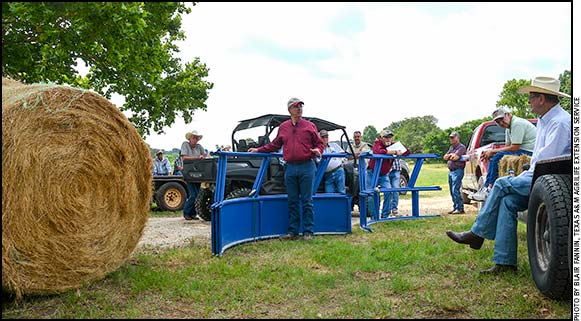
Larry Redmon, Texas A&M AgriLife Extension Service state forage specialist from College Station, discusses hay storage options at the O.D. Butler Forage Field Day hosted recently at the Camp Cooley Ranch division of Circle X Land and Cattle Co.
Hay Storage, Forage Management Discussed at Forage Field Day
Expert discusses the costs of wasted hay vs. the costs of building a hay barn.
Producing hay requires both time and expense, but it can lead to unwanted waste if bales are left sitting in the field, according to experts.
To preserve nutritive value and money, there are options that can be implemented to manage unwanted waste, said Larry Redmon, Texas A&M AgriLife Extension Service state forage specialist, College Station.
Redmon shared several options with producers at the recent O.D. Butler Forage Field Day hosted at the Circle X Land and Cattle Co. Camp Cooley Division in Robertson County.
“A barn can pay for itself in four to six years, according to studies done by our Extension economists,” Redmon said. “Many think they can store hay outside, but when hay costs as much as $120 a ton to produce, can we afford to give up some of that expense? Many of us can’t.”
During the demonstration, Redmon peeled back several layers of hay from a bale that had been sitting outside for more than a year.
“The good hay is in the center,” Redmon said. “A cow knows where the good hay is.”
As a result, a lot of undesirable hay will be pulled away by the cow from the bale and left on the ground. Redmon explained a producer could go through the proper steps to produce good-quality hay but still have losses due to improper storage.
“Once you’ve got a good soil test, you apply the fertilizer to the soil test recommendations. Then you cut it, bale it and you do everything right except you leave the hay out in the field. You’ve lost one-third to one-quarter of your hay.”
Redmon said some producers might not have the budget to pay for a barn.
“A barn will pay for itself because you don’t lose all that hay, but some of us can’t afford a good barn,” he said. “However, we can use hay tarps. You can get a hay tarp to fit on your pyramid stack. It’s important to stack in a pyramid to form air channels. It moves the air and keeps those bales dry. A barn also doesn’t have to have a concrete floor. Just good slope and sandy soil is all that is required.”
Also at the field day, James Jackson, AgriLife Extension specialist in Stephenville, discussed herbicide options for controlling broadleaf weeds, ryegrass and sandburs in hay fields. He discussed several herbicides, including Esplanade®, which has the active ingredient Indaziflam. It is still in the testing and development phase and is not yet commercially available for range and pasture use.
“For our ryegrass control demonstration, we sprayed ryegrass at five different treatments,” Jackson said. “These demonstrations were established on Oct. 27, which was 204 days prior to the field day.”
Some producers appreciate the ryegrass that comes up volunteer for the grazing benefits it offers, he said. Others consider it a weed that can hinder hay production. He said the point of his demonstration was to show producers what tools could potentially be available for future forage production.
“If a producer decided to spray for ryegrass, you can have a cleaner first cutting of hay and potentially a higher yield,” he said.
However, if a producer decided to spray the ryegrass, they would miss the grazing benefits that if offers to livestock, Jackson said.
For sandbur control, the demonstrations included Esplanade, Esplanade plus Pastora®, Esplanade and Cimarron® Plus, and Prowl® H20. Each of the six treatment plots used varying rates of mix, giving producers several ideas of how they might apply them to their own rangeland.
“Overall, we want to show producers several options and what may be available in the future to choose from in managing their forage production,” Jackson said.
Watch this video to learn more: https://youtu.be/dfIAi3EPq7M.
For audio interviews on this topic, listen to the links below:
- http://agrilife.org/agnewsarchive/files/2017/05/Dr.James-Jackson-ButlerFieldDay2017.mp3
- http://agrilife.org/agnewsarchive/files/2017/05/Dr.-Larry-Redmon-ButlerForageFieldDay2017.mp3.

Editor’s Note: Blair Fannin is a media relationship specialist with Texas A&M AgriLife Communications.






